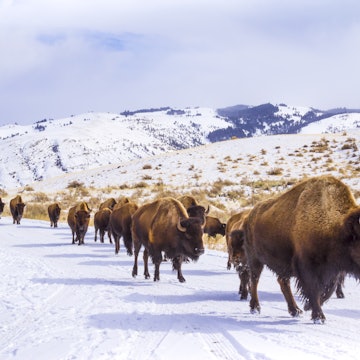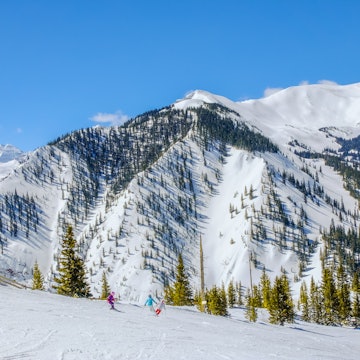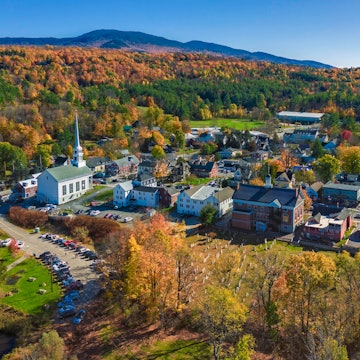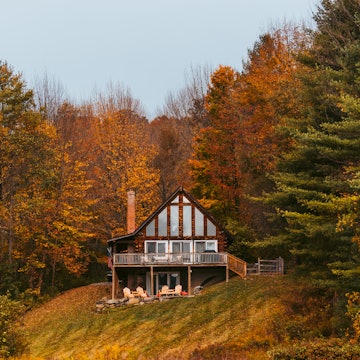

Yellowstone River wending its way through Hayden Valley © Matt Munro / Lonely Planet
America’s national parks have been called the country’s best idea – and it’s an idea that took hold in the wondrous pocket planet that is Yellowstone, the world’s first and, some would argue, most magnificent, national park. Following are my humble notes on exploring Yellowstone National Park.

Notes on exploring Yellowstone National Park
"I sat there in amazement while my companions came up, and after that, it seemed to me that it was five minutes before anyone spoke." So wrote Charles Cook in 1869, recording his expedition’s dumbstruck arrival at the head of a 20-mile-long, 1200ft-deep gorge crowned by a mighty green cataract and flanked with steaming, hissing walls of crimson, mauve and yellow.
Cook’s expedition had been dispatched to the lonely Montana-Wyoming border after wide-eyed fur trappers and prospectors came back from the region with tall tales of hot waterfalls that rose upward, of petrified forests and an alien world of fire and brimstone that trembled underfoot and belched orange gas and boiling mud. Silenced awe became the Cook party’s default mode; it was all true. That such a well-trodden nation, by then already an established global superpower, should have secretly nurtured this extraordinary lost kingdom seemed almost unbelievable. For most, it still was: the US government accepted Cook’s account only when a further expedition returned with irrefutable photographic evidence.

Upon my arrival
Approaching Yellowstone National Park, I can understand the skepticism. Wyoming, where 96 percent of the park lies – the rest is in Montana and Idaho – is dominated by the discouraging, dun-colored nothingness of the High Plains in the southeastern part of the state. The scenery wakes up in northwestern Wyoming outside Cody, a city founded by and named after William “Buffalo Bill” Cody, and suddenly I’m driving through mighty canyons and gilded forests. A wide-open-sky sunset lends every vista a cinematic majesty.
By the time I pass beneath the twilit pine-log eaves of Yellowstone’s eastern entrance, I’m beginning to channel Charles Cook, to grasp the sudden surge of protective pride that led to the 3000 astounding square miles before me being enshrined – just two years after its resident wonders were proven to exist – as the world’s first national park. "Withdrawn from settlement, occupancy or sale," the 1872 Yellowstone Park Protection Act stirringly decreed, "for the benefit and enjoyment of the people."
The Lake Yellowstone Hotel
The Lake Yellowstone Hotel overlooks a vast and placid body of moonlit water. Built in 1891 and designated a National Historic Landmark two years ago, the hotel exudes the genteel grandeur of a bygone tourist age, with a White House–grade portico, iron bedsteads primly clad in sheets, and an unapologetic absence of TV and air conditioning. As I patrol the endless corridors and cavernous reception areas, my lungs remind my head that we’re more than 7000ft above sea level. "We’re all suckers for nostalgia," says a uniformed receptionist. "Folks come here to see what their country used to look like and to experience it how those early visitors did."

The explosive Yellowstone
Simply getting to Yellowstone in the pre-railway age was a substantial undertaking. The reward that made it all worthwhile was firsthand experience of the park’s uniquely weird geothermal wonders. Yellowstone is home to more than half of the world’s geysers, fumaroles, hot springs and other related phenomena, and the sole founding purpose of Yellowstone National Park was to save them from mineral exploitation and the tacky intrusiveness that had recently despoiled Niagara Falls.
In 1872, the New York Times described the contemporary fascination with these "extraordinary and sometimes terrible manifestations of nature," though back then they didn’t know the half of it. Only in recent decades have researchers established that the 40-mile circular area encompassing the world’s most famous geyser, Old Faithful, is a gigantic caldera – the collapsed cone of a supervolcano. Yellowstone erupts on average once every 650,000 years, in the process entombing half a continent under many feet of ash, and pitching the entire planet into a dark and poisoned volcanic winter. It last did so 640,000 years ago. This knowledge lends a touch of portent to my tour of the park’s magma-related wonders.
Old Faithful does its job, firing a glittering hot sheaf of water at least 100ft into the blue sky before an amphitheater of video cameras. More compelling are the sprawling geothermal areas of Norris Geyser Basin, the hottest and oldest thermal area, and Grand Prismatic Spring, at 370ft in diameter the park’s largest hot spring. These boiled and flatulent prog-rock moonscapes are fringed by sickly pines, both a retrospective of how Earth began and perhaps a preview of its apocalyptic end. No natural wonders are more gloriously unnatural: the crusted oranges and iridescent blues look as pure and wholesome as the runoff from a battery factory, with a reek to match.
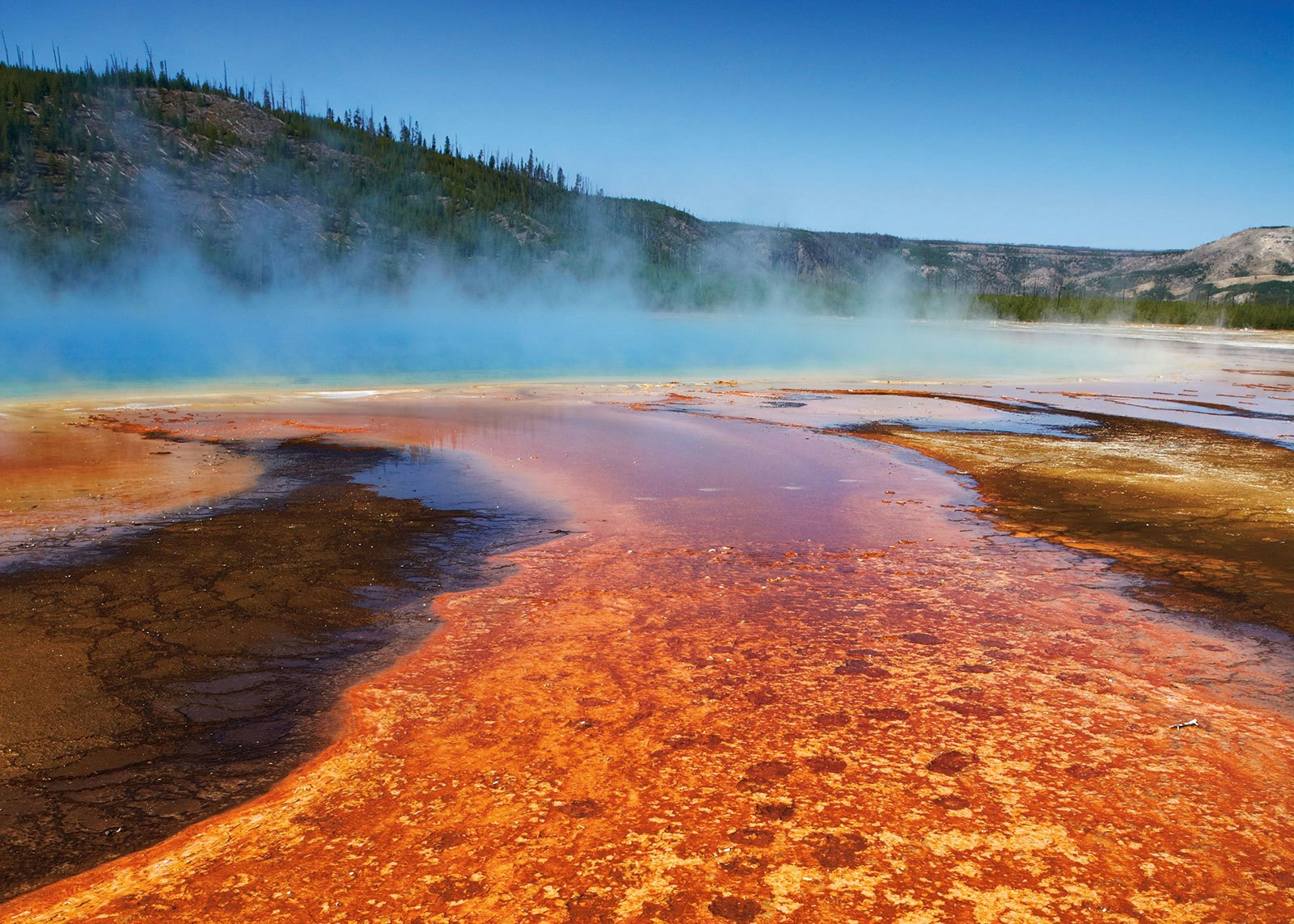
Founding the National Park Service
Yellowstone’s administrators were oblivious to the park’s nonvolcanic treasures until the late 1880s. Ancient forests were disappearing across the nation and entire species were pushed to the brink of extinction, notably the native bison population, which had been reduced from millions to less than 1000. By 1902, poachers had further reduced the bison herd to about two dozen. "We’re a country rich in resources and it’s still in our pioneering psyche to want to grab and exploit them to the full," says regular visitor and amateur naturalist Stacey Allen, peering through an enormous spotting scope across a flood plain dotted with a few of the 5500 bison that today roam freely through Yellowstone National Park. "It took real courage to draw a line in the sand here and say 'enough.'"
By ring-fencing its volcanic attractions, the park’s directors had accidentally created a huge and suddenly rare nature reserve. To safeguard it against poachers, the military was brought in. In 1916, with a world war to fight and a massive surge of tourists in Ford Model Ts to marshal, the Army gave way to the newly created National Park Service. Today, the NPS oversees more than 400 properties, including 59 designated national parks – from Alaska to Hawaii and including US territories – that cover more than 84 million acres and attract 300 million visitors annually. With its devotion to recycling and other environmental initiatives, the NPS has been a beacon in the fog that sometimes shrouds America’s environmental awareness.

Reintroducing the gray wolf
Another species that has benefited from national awareness of environmental issues is the gray wolf, which was present when Yellowstone was established but had virtually vanished by the mid-1900s. Having been systematically eliminated, wolves were successfully reintroduced in 1995 – a missing link in a food chain then topped by the coyotes that were killing off the park’s pronghorn antelope. The NPS estimates that as of January 2016, there were at least 98 wolves in 10 packs living within the park, and 528 wolves in the Greater Yellowstone Ecosystem.
People still come to Yellowstone for the geothermal action – "I mean, how many times can you say you rode your bike round the rim of a volcano?" says one of the many Harley-Davidson riders who file through at the stately 45 mph speed limit – but they stay for the wildlife. With one of the largest concentrations of wild animals in America, Yellowstone offers a virtually unparalleled opportunity to see animals in their natural habitat. Topping most visitors’ want-to-see list are wolves, bison (large herds are a common sight), bears (Yellowstone is home to grizzlies and black bears), moose (fewer than 200 remain in the area) and elk. Also in the park are pronghorn, badgers, bald eagles, trumpeter swans, foxes and, though they’re rarely seen, wolverines and lynxes.
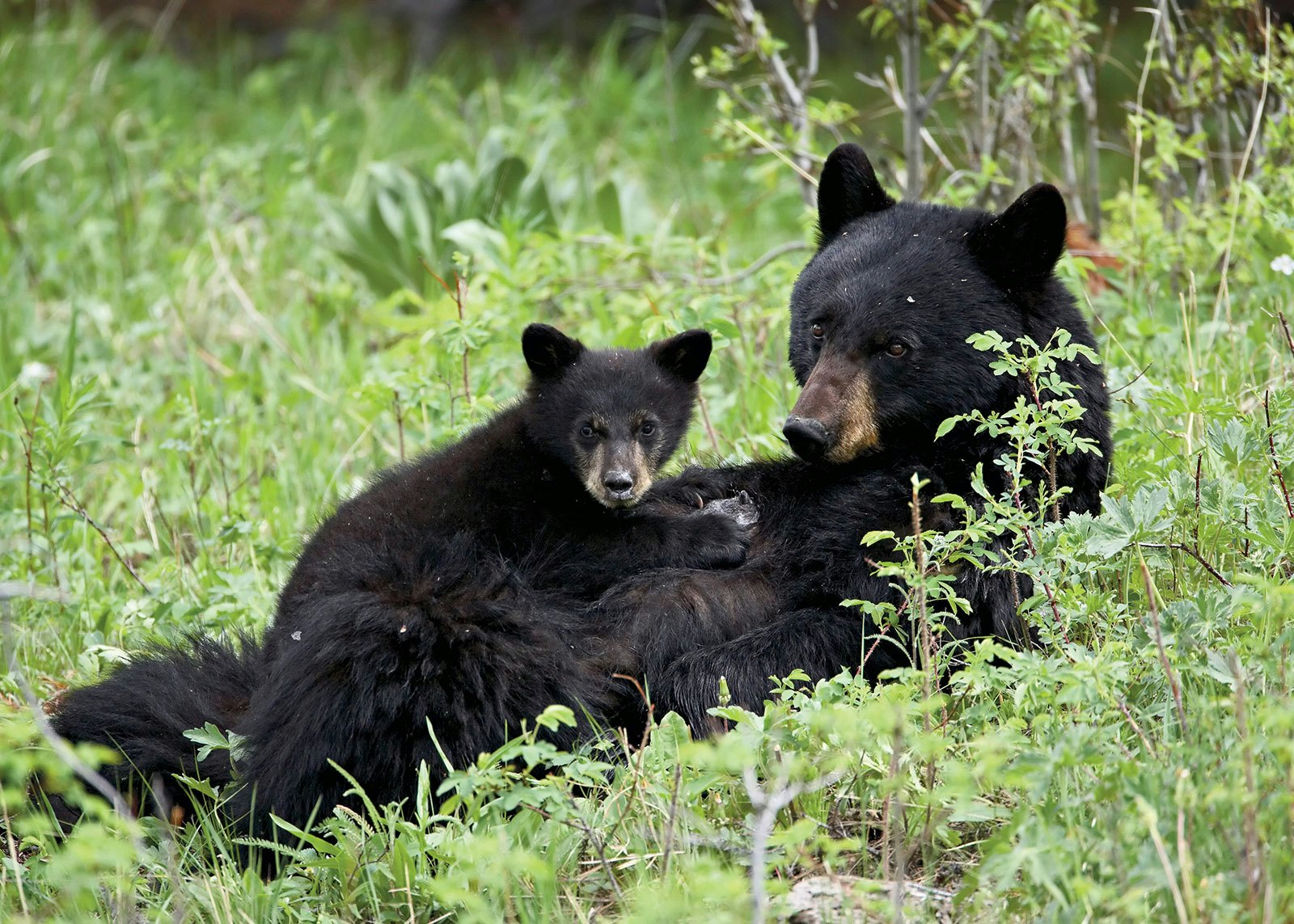
Observing wildlife
Spring is the best time to see baby animals, including grizzlies, which emerge from their dens in March, and bison, which are born in April and can be spotted with their herds throughout spring, summer and fall. Elk are seen throughout the park – their summer population is estimated at 15,000 to 25,000 – and the best time to see them at lower elevations is during their mating season, early September to mid-October.
A proven method for observing wildlife, especially bears: drive around until you hit a logjam of parked vehicles, then get out to see what everyone has stopped to look at. Yellowstone’s roads cover just five percent of the park, yet within a couple of days’ driving I encountered every landmark species except a wolf: a bull elk in the roadside pines, bugling hopefully for a mate; a speckled osprey, posing for an hour on a conspicuous bough overlooking a roadside pull-off; a moth-eaten coyote halfheartedly stalking a pronghorn; and most of the park’s bison, rolling about in the dust, grazing in the dawn mist or ambling en masse up the road, their huge minotaur-like heads brushing my vehicle’s side-view mirrors.
So confidently approachable does the wildlife seem, that you begin to wonder if they’ve been bribed to satisfy the very low boredom threshold of any Disney-fed visitors who come expecting sights to be served up on demand. A crowd gathered in the churchyard of Mammoth Hot Springs, the small town built for the park’s original military guardians, leads me to a black bear asleep in a tree. Someone says it was spotted by guests at an afternoon wedding, as the photographer marshaled the bride’s family beneath. National Park Service ranger Bridget Hand is standing by to make sure that everyone keeps a safe distance. "Yellowstone is like a pocket wilderness, an accessible place for people who live in big cities and have never, ever experienced wildlife in a natural setting," she says. "I get asked where we put the animals at night."

Yellowstone: the pocket planet
Alex and Danielle Sonsini are experienced national parkers, so they’re not likely to be asking too many ill-informed questions. It’s been four weeks since they hitched a lovingly restored 1968 Avion caravan recreational vehicle to their pickup truck and set out from New York City, with venerable Labrador retriever Augie sitting between them.
"A couple of years back we did a five-month trip all the way to Alaska and back, stopping in every national park along the way," says Danielle, who chucked in a high-flying career in information technology to satisfy her wanderlust. "Out in these places you see unspoiled scenery, but you also find unspoiled people." Alex, a corporate chef-turned-sculptor, feels plugged into the oldest American tradition. "Our country was founded by pretty adventurous travelers, and then explored by pioneers in covered wagons. We never have an itinerary when we set off on a trip – it’s just about wherever the road takes us."
It’s a comment that resonates throughout the balance of my tour. Yellowstone is more than a pocket wilderness. It’s a pocket planet, a theme park of iconic global scenery. Germanic pine forest, mouthwash-blue Scandinavian waterfalls, the Russian steppes, Mexican scrubland, boggy Gaelic moors and even a swathe of sub-Saharan savannah: it’s all here. Yellowstone even gets around-the-world weather packed into a day, from sub-zero mist to wilting sun, via a couple of thundery hailstorms. Yet at the same time, this place is like nowhere else on Earth. The Grand Canyon of the Yellowstone, that psychedelic cleft in the land that reduced Charles Cook to slack-jawed silence, might more convincingly belong in another solar system.

For the benefit and enjoyment of the people
At the Sonsinis’ suggestion, I round off my trip with another utterly incomparable experience: Boiling River, the only place in Yellowstone where you’re allowed to swim, and for much of the year the only place you’d want to. A half-mile walk from an anonymous parking lot follows the frigid Gardner River to its confluence with the aforementioned geothermal spring. Here, an artful arrangement of rocky pens blends the skin-flaying and bone-chilling waters. Each is home to half a dozen lolling bathers, their blissed-out, parboiled faces as red as the setting sun behind them. They are at one with the volcanic heritage that secured this park its pioneering protected status and, in doing so, kick-started the whole concept of environmental stewardship.
"For the benefit and enjoyment of the people," I think, stripping down to my underwear and treading gingerly over the slippery stones to join them. Then I lie back with my head on a smooth boulder, gaze dreamily around at the lumpy brown hillsides and let the sulfurous warmth embalm me, a benevolent gift from the volcanic gods, who, if we’re lucky, will stay asleep for another few hundred thousand years.
Tim Moore traveled to Yellowstone National Park with support from the Wyoming Office of Tourism (visitwyo.gov) and Yellowstone National Park Lodges (yellowstonenationalparklodges.com). Lonely Planet contributors do not accept freebies in exchange for positive coverage.
This article was originally published in June 2017. It was updated August 2020.







